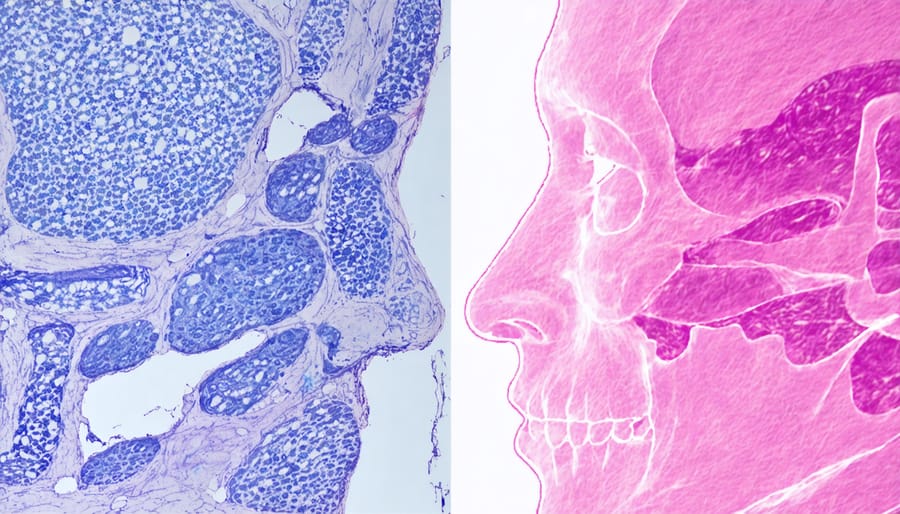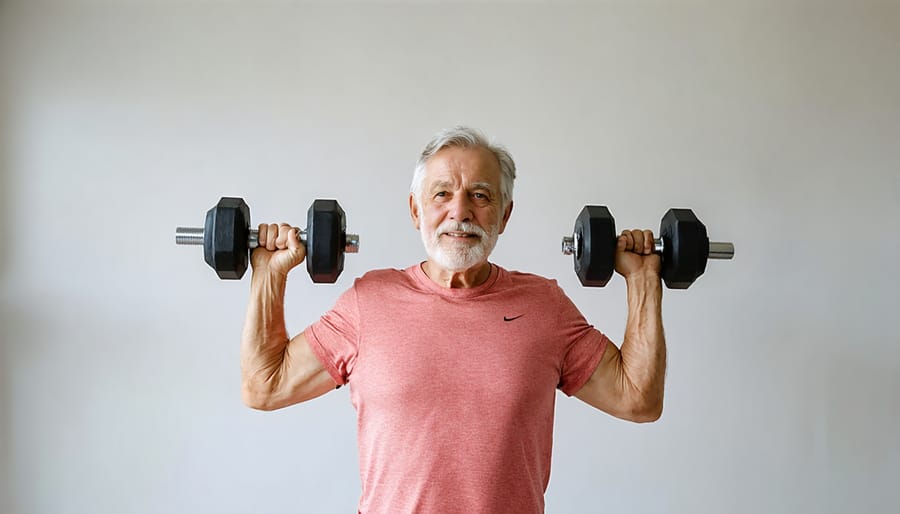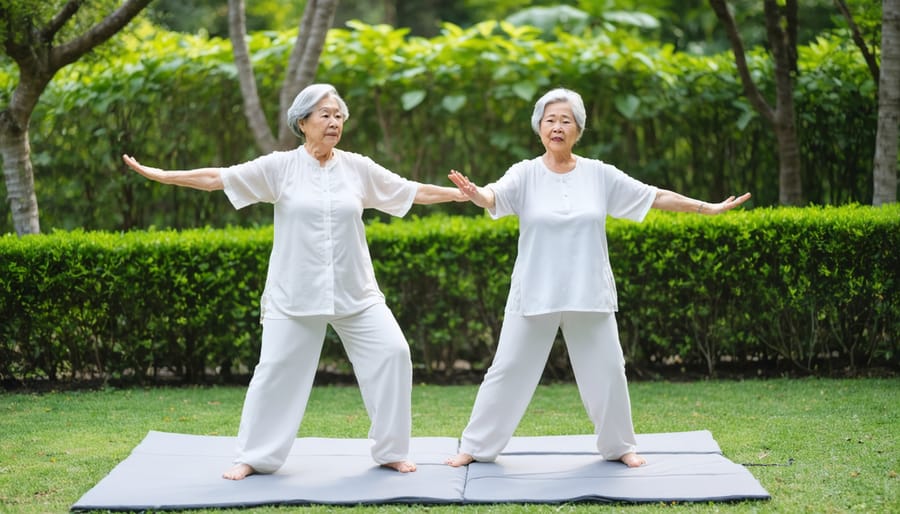Exercise fundamentally reshapes how we age, offering a powerful way to transform your life after 50 and beyond. Scientific evidence consistently shows that regular physical activity reduces the risk of age-related diseases by up to 50%, enhances cognitive function, and maintains muscle mass essential for independence. The World Health Organization now recognizes exercise as the single most effective intervention for healthy aging, surpassing both dietary changes and medication in its impact on longevity and quality of life. While genetics influence how we age, research demonstrates that consistent physical activity can effectively slow cellular aging, improve bone density, and boost immune function well into our later years. This evidence-based approach to aging isn’t just about adding years to life—it’s about adding life to years through movement that matters.
Why Exercise Matters More After 50
The Biology of Aging
As we age, our bodies undergo various natural changes that affect how we function and feel. These changes include a gradual decrease in muscle growth and development, reduced bone density, and slower metabolism. Our cardiovascular system becomes less efficient, making it harder for oxygen to reach our muscles and organs. Hormone production changes, affecting everything from our energy levels to how quickly we recover from physical activity.
Our joints may become stiffer due to changes in cartilage and connective tissues, while our balance and coordination can decline as our nervous system processes information more slowly. We also experience changes in body composition, with a tendency to lose muscle mass and gain fat tissue.
However, it’s important to understand that while aging is inevitable, the rate and extent of these changes can be significantly influenced by lifestyle choices. Regular physical activity, proper nutrition, and maintaining social connections can help slow down many age-related changes and maintain better function throughout our later years.

Exercise as Medicine
Regular physical activity is increasingly recognized as a powerful medicine for healthy aging, supported by extensive scientific research. Studies consistently show that exercise acts as a natural remedy for many age-related health concerns, offering benefits comparable to, and sometimes exceeding, traditional medical treatments.
Research published in the Canadian Journal of Public Health demonstrates that older adults who exercise regularly experience a 30-40% reduction in the risk of chronic diseases, including type 2 diabetes, heart disease, and certain cancers. Physical activity has also been shown to improve bone density, reducing the risk of osteoporosis and fractures by up to 50%.
Beyond physical health, exercise serves as a potent mood enhancer and cognitive protector. Regular movement increases the production of endorphins and other beneficial brain chemicals, helping to prevent depression and anxiety. Studies indicate that physically active seniors are 40% less likely to develop cognitive decline and dementia compared to their sedentary counterparts.
Perhaps most importantly, exercise helps maintain independence and quality of life, with active older adults reporting greater mobility, better balance, and enhanced ability to perform daily tasks well into their later years.
Building Your Age-Optimized Exercise Plan
Strength Training: Your Anti-Aging Powerhouse
As we age, one of the most powerful tools in our wellness arsenal is strength training. While many people associate resistance exercise with younger athletes, research shows it’s particularly beneficial for older adults. Understanding strength training fundamentals is crucial for maintaining independence and vitality throughout our later years.
Regular strength training helps combat age-related muscle loss, known as sarcopenia, which typically begins around age 30 and accelerates after 50. By incorporating resistance exercises into your routine just two to three times per week, you can maintain muscle mass, increase bone density, and improve balance – all critical factors in preventing falls and maintaining mobility as you age.
The benefits extend beyond physical strength. Resistance training has been shown to boost metabolism, improve insulin sensitivity, and enhance cognitive function. It also helps manage chronic conditions like arthritis, diabetes, and osteoporosis, which become more common with age.
Starting a strength training routine doesn’t require expensive equipment or gym memberships. You can begin with bodyweight exercises like squats, wall pushups, and chair dips. As you build confidence, you might add resistance bands or light dumbbells to your routine. The key is to start gradually and focus on proper form rather than heavy weights.
Remember to include exercises that target all major muscle groups: legs, hips, back, chest, abdomen, shoulders, and arms. Aim for 10-15 repetitions per exercise, and always allow at least one day of rest between strength training sessions to allow your muscles to recover and rebuild.

Cardiovascular Fitness for Longevity
Regular cardiovascular exercise plays a vital role in maintaining heart health and promoting longevity. As we age, keeping our hearts strong becomes increasingly important through consistent aerobic activities. Making heart-healthy lifestyle changes, including regular exercise, can significantly impact our quality of life in later years.
For optimal cardiovascular fitness, aim for at least 150 minutes of moderate-intensity aerobic activity or 75 minutes of vigorous activity spread throughout the week. Moderate activities include brisk walking, swimming, or cycling at a comfortable pace. If you’re just starting, begin with 10-minute sessions and gradually increase duration as your fitness improves.
To make your cardiovascular workout more effective:
– Start with a 5-10 minute warm-up to prepare your body
– Maintain a pace where you can talk but not sing
– Monitor your heart rate to stay within your target zone
– Cool down properly to avoid light-headedness
– Stay hydrated before, during, and after exercise
Listen to your body and adjust intensity as needed. Some days you might feel energetic enough for a challenging workout, while others may call for gentler activity. The key is consistency rather than intensity.
Consider incorporating variety into your routine to prevent boredom and work different muscle groups. Try activities like water aerobics, dance classes, or Nordic walking. These options are particularly joint-friendly while providing excellent cardiovascular benefits.
Remember that it’s never too late to start improving your cardiovascular fitness. Even small increases in physical activity can lead to meaningful health benefits and contribute to a longer, more active life.
Balance and Flexibility: Preventing Falls and Maintaining Mobility
As we age, maintaining balance and flexibility becomes crucial for preventing falls and preserving our independence. Research shows that regular balance and flexibility exercises can reduce fall risk by up to 40% in older adults while helping maintain mobility for daily activities.
Simple balance exercises you can practice at home include standing on one foot while holding onto a chair, walking heel-to-toe (as if on a tightrope), and gentle weight shifts from side to side. Start with 30 seconds for each exercise and gradually increase duration as your balance improves. For added safety, always perform these exercises near a sturdy surface for support.
Flexibility exercises help maintain joint range of motion and reduce stiffness. Gentle stretching of major muscle groups, including hamstrings, calves, shoulders, and hip flexors, should be performed daily. Hold each stretch for 15-30 seconds without bouncing, and remember to breathe normally throughout the movement. Activities like yoga and tai chi are excellent options that combine both balance and flexibility training while being gentle on the joints.
To maximize benefits and safety:
– Warm up before stretching with a short walk or light movements
– Never stretch to the point of pain
– Practice balance exercises when you’re fresh and alert
– Wear comfortable, supportive footwear
– Stay hydrated and exercise in a well-lit area
– Consider joining a supervised exercise class designed for older adults
If you experience dizziness, severe joint pain, or unusual weakness, consult your healthcare provider before starting or continuing these exercises. Regular practice of balance and flexibility exercises, combined with other forms of physical activity, creates a solid foundation for maintaining independence and enjoying an active lifestyle as you age.

Safe Exercise Strategies for Older Adults
Getting Started Safely
Before starting any new exercise program, consult with your healthcare provider, especially if you have existing health conditions or haven’t been physically active recently. They can help determine which activities are safe and appropriate for your fitness level.
Begin gradually with light activities like walking, stretching, or gentle swimming. Start with 10-15 minutes of activity and slowly increase duration and intensity as your fitness improves. Listen to your body and watch for signs that you’re doing too much, such as excessive fatigue, joint pain, or shortness of breath.
Proper warm-up and cool-down periods are essential. Spend 5-10 minutes doing light stretches or walking before your main activity, and repeat afterward to help prevent injury and reduce muscle soreness.
Choose activities you enjoy and that match your current abilities. Consider joining senior fitness classes or working with a certified fitness instructor who can demonstrate proper form and technique. Many community centers offer programs specifically designed for older adults.
Stay hydrated by drinking water before, during, and after exercise. Wear comfortable, supportive shoes and appropriate clothing for your chosen activity. Exercise in a safe environment with good lighting and even surfaces to prevent falls.
If you experience chest pain, severe dizziness, or unusual shortness of breath during exercise, stop immediately and seek medical attention. Remember, progress takes time, and it’s better to start slowly and build up gradually than risk injury by doing too much too soon.
Adapting Exercise to Your Needs
Exercise can and should be adapted to meet your individual needs, abilities, and health conditions. If traditional exercises feel challenging, there are many effective modifications you can try. For instance, if running puts too much stress on your joints, consider low-impact alternatives like swimming, water aerobics, or cycling.
Chair exercises are excellent options for those with balance concerns or limited mobility. Simple movements like seated leg raises, arm circles, and chair yoga can help maintain strength and flexibility. When weight-bearing exercises are difficult, resistance bands offer a gentler way to build muscle strength.
For those with arthritis or joint pain, gentle stretching and range-of-motion exercises in warm water can help reduce stiffness while providing natural resistance. If traditional push-ups are too challenging, try wall push-ups or counter push-ups to build upper body strength gradually.
Remember that any movement is better than no movement at all. Even daily activities like gardening, walking while shopping, or dancing can contribute to your fitness goals. The key is to start slowly and progress at your own pace, listening to your body’s signals.
If you’re unsure about which modifications are right for you, consider working with a qualified fitness instructor or physiotherapist who can develop a personalized exercise plan that accounts for your specific needs and health conditions.
Exercise is a cornerstone of healthy aging, offering profound benefits for both physical and mental well-being. Throughout this article, we’ve explored how regular physical activity can help prevent chronic diseases, maintain independence, and enhance quality of life as we age. The evidence is clear: it’s never too late to start moving and reaping the rewards of an active lifestyle.
Remember that successful healthy aging through exercise involves a balanced approach combining aerobic activities, strength training, flexibility work, and balance exercises. By incorporating these different types of movement into your weekly routine, you can build a strong foundation for long-term health and vitality.
The key takeaway is that every step counts. Whether you’re just beginning your fitness journey or looking to maintain your current activity level, focus on making sustainable changes that you can maintain over time. Start slowly, progress gradually, and celebrate small victories along the way.
Safety should always be your priority. Listen to your body, work within your limitations, and don’t hesitate to seek guidance from healthcare providers or qualified fitness professionals when needed. Remember that modifications are not signs of weakness but smart strategies for long-term success.
As we’ve discussed, the benefits of exercise extend far beyond physical health. Regular activity can boost mood, reduce stress, improve sleep quality, and provide valuable opportunities for social connection – all crucial elements of healthy aging.
Take action today by choosing one small change you can make to become more active. Perhaps it’s a daily 10-minute walk, joining a gentle yoga class, or trying some basic strength exercises at home. Whatever you choose, know that every movement contributes to your health and well-being.
Your journey to healthy aging through exercise is personal and unique. Embrace the process, stay consistent, and remember that it’s never too late to invest in your health through regular physical activity.

